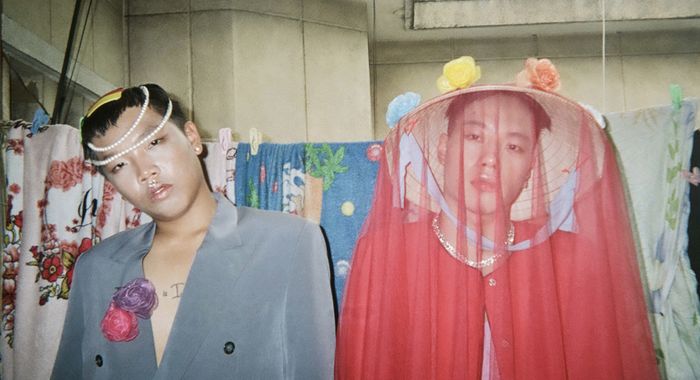Celebrating The Carnival Costumes of Artist Clary Salandy
Whilst Carnival may have been online this year, it’s Carnival in the flesh the moment you step into Mahogany Carnival Design. Established in 1989 by husband and wife Michael Ramdeen and Clary Salandy, the pair have been based in Harlesden since 1996 where they create beautiful, larger than life Carnival costumes. The Time For Change Is Now is the theme of the costumes for 2020 and will be showcased virtually for this year's Notting Hill Carnival. We spoke to designer Clary about the messaging and stories behind her work.
Spirit of The Mask
“The mask is a very important part of Carnival and of our culture. The Black community are a very spiritual race, our origins are rooted in rituals. In Africa when they do rituals they use face patterns and masks for different ceremonies. In the old days the person who made the mask would have to pray before transforming God’s material. We’re paying a tribute to those African traditions, handed down to us from our ancestors”
Tribute To Africa
“That set tells a whole story of Africa, from the land, the animals and the rituals of the people”. The body costumes echo the shape of the animal with the puffy sleeves representing the muscular shape of the animal's legs. The piece pays homage to and the richness of African land and its animal life. “Again we’re giving a tribute to Africa, which is the real root of Caribbean carnival”.
Spirit of Emancipation
When closed, this costume represents the slaves in captivity, “that's the first spirit, the torturous spirit of being captive”, when open they represent the element of freedom but not really being in control. “What she does with her body makes them move, if she stands still they're still [and] when she moves they move in different directions. The performer has control [and] you are not in control in your destiny. What is in control of your destiny is far greater than any of us”. There is also a religious significance in this piece, “that whole thing about the trinity, it’s like the crucifix, Jesus in between the two thieves”. This significance carries over to the origins of Carnival - which began as a pre-lenten Roman Catholic festival. “The revelry and the fun is before the 40 days of abstinence”. Whilst this may not be the case for Notting Hill Carnival, it rings true in Trinidad Carnival which takes place two days before lent. “Anything that comes out of the Caribbean all has roots in Trinidad. The watering down of Carnival [in] London means that the Caribbean voice is diminishing within its own festival! The spirit of emancipation is important for that reason [it shows] not being in control, being captive and then being free-ish. Free-er so you can move and stand and dance. That's what that is, the spirit of emancipation”.
Blitz
After the devastation of WWII, many people from the Commonwealth were invited to England to work and rebuild their Mother Country. “That’s the whole reason for everything, if it wasn't for the war then this whole story wouldn’t exist”. The headpiece of the costumes shows St Paul's Cathedral amongst the London skyline, all ablaze, with the flaming orange fabric being the aura and glow of the fire and disaster that ignited the whole story of the Caribbean community in London.
Arriving In Waves
This costume is the Empire Windrush that first sailed in 1948, three years after the end of the war. The abstract figures at the top includes steel pan and soldiers, representing the people and their skills that rebuilt and changed the culture of Britain.“The thing about it arriving in waves, a lot of the people who were on that first ship left their children behind, so there was a second wave and a third wave, as a result of people who came first”. Windrush saw over 500,000 people settle in Britain between 1948 and 1971. “The Windrush scandal was so devastating; that generation is extremely important within the Caribbean community. We would not have Carnival if it were not for that community of people.”
Rivers Of Blood
The racist, anti-immigrant rivers of blood speech was given in 1968 and was followed by high levels of racism in the UK, “preventing them from being able to have a life and making life for Black people in England difficult”. This costume gives tribute to the lives lost. “The blood that has been spilt, the blood of Black people” . Despite the heavy tone, the costume still has a joyous feel. “The joy on her face is the joy of saying, you did not kill us, you may have spilled our blood but you did not kill our spirit. You can’t kill the black spirit. Even in death, we rise”.
The Importance of Family
“Family is at the centre of the community”. This costume, featuring a real mother and daughter, showcases how we nurture the next generation and pass on our traditions. “The mother is making sure that the next generation is [growing up] within Carnival. We have to inspire the next generation [and] Carnival is a way of teaching and learning. The community spirit comes from families taking part in Carnival together”.
Emerging Forms
“There is a notion that all life started in Africa”. This piece represents the multitude of races within a person's ancestry. “It means that new races of people are emerging all the time through the mixing of cultures. No person is one thing, we’re all a mix, that's what emerging forms is about”
Justice & Equality
If we can get justice and equality right then we’re really looking at a much better world for everybody. There would be no need for [people] to steal if they had what they needed. If the system allowed a level of equality and everybody had the basics of what they need that would be a really good scenario .
Black Spirit
The theme of “The Time For Change Is Now” arose from this piece which is in honour of George Floyd. “He should have been the full stop but he’s not been”. The person inside the costume represents a spirit in the spirit realm. “It's a manifestation of that sense of a spirit, which is there and not there. You can see through it but it’s forever there. We will be forever here”.
It was always obvious to me that Clary is a talented artist. However after gaining insight into the theme this year, it becomes clear that she is also a talented storyteller. Beautifully telling the political story of the Caribbean diaspora’s journey in Britain, she firmly believes that we have a part to play in keeping our history alive. Notting Hill Carnival has strayed far from the political and societal resistance it was founded on. “The focus is [now] on party and while they’re focused on partying they're missing the opportunity to stand up for their rights. Carnival is part of the civil rights movement. Black people were not allowed to participate in Carnival in the Caribbean, there were laws to stop us, so every inch that we get we have to hold onto and we have to continue to represent our people, our heritage, our future!”
For the first time since its origin, we will not be marching the streets of Notting Hill in jubilation, but instead resorting to a virtual experience. “When we’re back on the streets of Carnival we will have more stories to tell. [But for now] it’s an exciting opportunity for people to see everything that they may not see on the road. The aspiration is, stay well and stay safe so we can be back on the road having a marvellous Carnival, next year”.
Follow Mahogany Carnival on Twitter here and Instagram @mahoganycarnival.
Virtual Notting Hill Carnival is streaming at www.nhcarnival.org
August Bank Holiday - Saturday 29, Sunday 30 & Monday 31 August
Credits: Written by Rochelle Thomas / Photography: Derrick Kakembo Set Design: Amelia Tavenner / Filmed & Edited by Sheena Bonsu Brobbey.
Photographs taken on the Leica SL2.



